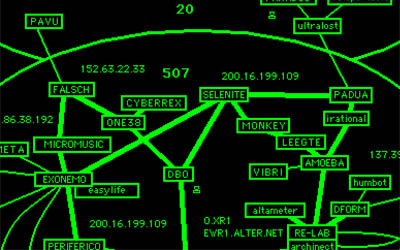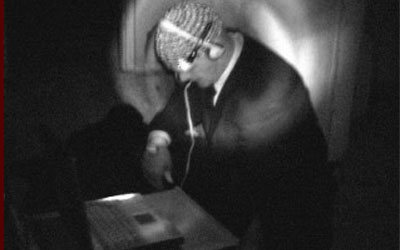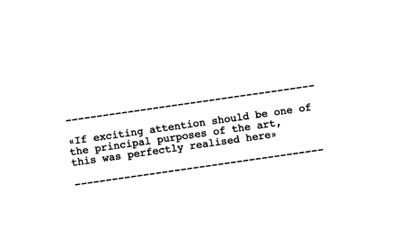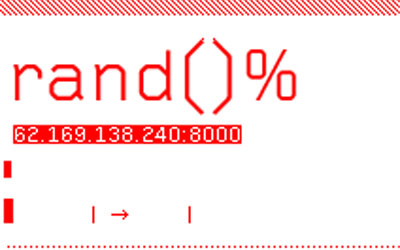 |
[October 3rd 2004]

5 Faves - picked by Thor Magnusson
Granted, surfing the net for nice new stuff can be quite time consuming
- and often you come across the good stuff by chance. We asked a
number of Nordic artist to help us surf by telling us their five
favorite picks. The assignment was quite open - it could be current
hits as well as all time greatests. Here is what the Icelandic UK
based artist Thor Magnusson sent us.
I find this difficult. After having thought about it a little,
I realised that it would be much easier for me to name 5 favorite
books, movies, or records. Why is that? The net is by its nature
a dynamic medium and in a constant state of change. A site that
was interesting 4 years ago could be absolute rubbish today and
vice versa. Also, the novelty of the net as an artistic medium has
resulted in critical confusion regarding the aesthetic value and
importance of certain works. This is all coming more into perspective
these days, I think, but around the height of the dotcom era, the
hype around some things was almost incredible. Often the concentration
was on the new form of net based works, but with little attention
paid on the content. It can be dangerous to make a strong distinction
between form and content, especially in computer based art, but
frankly, some of the works
weren't really interesting although the technical aspect was brilliant.

Jodi's map
Anyway, I personally am not so interested in the category net
art per se, but rather in the more general term processor art (as
I prefer to call it), i.e. the works of art that necessarily depend
on the central processing unit of a computer to become alive. Net
art, software art and generative art are of course included in this
category amongst other forms of computer art. (Excluded would be
static works made on a computer in programs such as Photoshop, Premiere,
Maya, etc., unless in very special cases). Since the topic here
is net based works, I will only mention works which live online.
Amongst the early stuff, I really liked the work of Alexei Shulgin
and his www.easylife.org
activities. He was part of a community exchanging ideas through
mailing lists around the birth of the net.art movement, such as
www.nettime.org, but
in the last few years he's been involved in other important projects,
such as being a rock star and organising the Read_Me festival for
software art. Other early pioneers would be www.jodi.org
whose formalistic experiments were always fun and powerful. They
actually made their subjective map in the early 00's of the net
art situation ( http://map.jodi.org).
Not everything is there, such as the world's first collaborative
sentence (http://ca80.lehman.cuny.edu/davis/)
started by Douglas Davis in 1994. I've heard it would now fill a
whole room of yellow pages books if printed. Vuc Cosic made some
interesting stuff, not to mention Heath Bunting, and so did Igor
Stromajer (http://www.intima.org/)
whose project Ballettikka Internettikka I like very much. (They
broke into the Moskow Ballet Bolshoi Theatre and broadcasted their
own pathetic ballet from the basement of the building). The whole
net.art (net DOT art) movement was finally formally epitaphed by
the Written in Stone exhibition in the Norwegian National Museum
for Contemporary Art in early 2003.

Fra Ballettikka Internettikka
At the end of the day, when trends are forgotten, it is always
the people who are the most important factor when looking at this
field of art and many of the people you'll find working in this
field today have been doing it for the last decade. A project that
I've always been fascinated by is the Life Sharing project of the
people behind 0100101110101101.ORG (http://www.0100101110101101.org/)
They actually started by creating the fictional identity of the
artist Darko Maver, or pretending to be someone else (jodi for example)
which in turn backfired when somebody (I forgot who it was) created
a fake website of 0100101110101101.ORG with a misplaced 0 or 1 and
pretended to be them. Anyway, I found the Life Sharing project was
so fascinating because they opened up their computer to the whole
world. One could access all
their documents, mail correspondence, system files, programs, images,
notes, basically everything on their computer and have a look. For
some reason they stopped the project. I wonder why? Recently they
just won a legal battle with Nike because of their latest project.

From 0100101110101101.org
Lately, the former Pogues member, Jem Finer, has been releasing
and performing some really wonderful music which he has composed
by writing computer code and playing guitar. His longest piece,
a generative on-line piece called Longplayer, is a 1000 year long
composition which
started in year 2000. Its original listening post is in the Lighthouse
of Trinity Buoy Wharf, in London, but now one can also listen to
it in the new library of Alexandria, Egypt and in Brisbane, Australia.
The work can also be heard live on the web as streaming mp3 signal.
It lives here: http://longplayer.org.

rand()%
More music can be found in the highly interesting project Rand()%
Radio (http://www.r4nd.org).
It is an automated real-time radio stream of generative music. It
broadcasts all year around music
generated by algorithmic software written by musicians or sound
artists. I guess it is the first online radio station that plays
exclusively generative music. The initiators of the station are
involved in other projects as well which are well worth mentioning:
See Tom Betts ( http://www.nullpointer.co.uk)
and Joe Gilmore (http://www.v3ctor.com
- check out Plank and Powerbooks for Peace ). Ah, while we're at
it, I might just mention the Soundscape-FM radio (
http://www.soundscape-fm.net/
) as well. It is hybrid of online radio and pirate radio, concentrating
on field recordings. It was set up by the people from Umatic in
Utrecht at the Garage Festival in Germany this summer.

runme.org
Finally, I think the most important project I can think of right
now is the Run Me repository created by Amy Alexander, Olga Goriunova,
Alex McLean and Alexei Shulgin. It is an anti-institutional, democratic
space which encourages open source culture where one can find loads
of interesting software art, generative art and texts about the
field of computer generated art. An important node in the hybrid
network of on-line computer art cultures. Here is the link: http://www.runme.org/
I guess this might be more than 5 favorite projects, but why 5?
|
 |
|